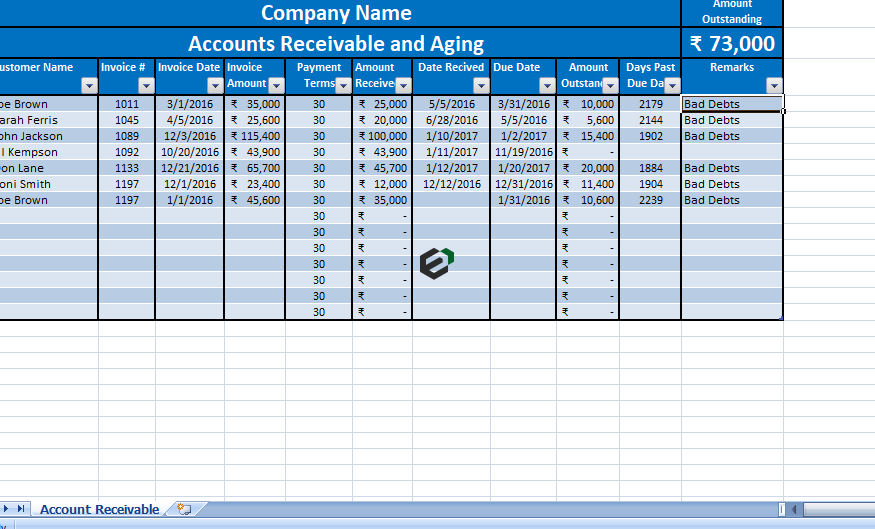
This collection tool makes it easy for businesses to identify late-paying customers and set invoice payment terms. An accounts receivable aging report is essential for maintaining a healthy cash flow and preventing collection issues from becoming major problems. It also reduces the risk of bad debts by analyzing customer payment habits. First, gather all outstanding invoices from your accounting system and organize them by customer. Next, define aging categories, such as 0-30 days, days, days, and over 90 days. Sum the amounts for each category to see the totals for each aging period.
How do I create an AR aging report?
The aging report is an essential tool to estimate potential bad debts used to revise allowance for doubtful debts. The general method is to derive the historical percentage of invoice dollar amounts and apply the percentage total columns of the aging report. First, to track overdue or delinquent accounts so that the company can continue to decide what to do with old debts. These may be sold to collections, pursued in court, or simply written off. The second reason is so that the company can calculate the number of accounts for which it does not expect to receive payment.
Manage your inventory and bookkeeping easier
- The software matches customer payments to invoices upon arrival and provides instant insights to AR managers.
- If there are several customers with overdue amounts that extend beyond 60 days, it may signal the need to tighten your credit policy toward existing and new clients.
- An accounts receivable aging report, also known as an aging schedule, will include unpaid invoices from your accounts receivable (A/R).
- To determine the amount of uncollectible accounts, an aging method is used for a collection system that is divided into time periods.
Once your accounts receivable aging report is ready, you’ll be able to spot which customers are late, how late they are, and how much they owe. You can then take action to get your outstanding payments addressed, such as sending a follow-up invoice or reaching out to a collection agency. If too many invoices remain unpaid for a prolonged period, it could lead to cash flow problems. To improve your cash flow management, set clear credit terms to encourage timely payments. Also consider incentives for early payments and apply late fees for overdue invoices. These steps motivate customers to pay on time, thus improving your cash flow.
How should is accounts receivable aging calculated?

The sum of the products from each outstanding date range provides an estimate regarding the total of uncollectible receivables. A good AR aging percentage will vary by the industry and credit terms the company offers. You can find the AR aging percentage by dividing the total amount of receivables that are over 90 days past due by the total amount of receivables outstanding.
By assessing credit risk, you can determine if your current credit policies are effective and make necessary adjustments to safeguard your cash flow and financial health. Evaluating credit risk involves analyzing the likelihood of customers defaulting on payments. Usually, a lower collection period is preferred over a higher one as it indicates how effective a business is in collecting payments on time. However, if your collection period is high, then your aging report will show more overdue accounts. Here’s when you might revisit your payment terms so that you can collect more of your dues on time.
And if there are no additions or write-offs, the balance in the account is zero. Both the aging and percentage of net sales methods, as well as other methods, are used in practice. The total of these figures represents the desired balance in the account Allowance for Uncollectible Accounts. A credit entry is made to Allowance for Uncollectible Accounts, thereby adjusting the previous balance to the new, desired balance.
This can make an aging A/R report misleading because if a customer pays just a few days later, it can show up as past due on the report. Once you nail down your account receivable aging report process, you will have a clear picture of your overdue accounts. It’s then time to move on to the nitty-gritty process of collections on those accounts. Once you understand the frequency at which you receive payments, you can even adjust your payment or sales policy. Instead of dropping customers who are on the borderline of being credit risks, you can follow up with them and use it as an opportunity to build stronger relationships.
Keep the language professional and concise, and always include contact information. This will make it easier for the customer to reach out with questions and arrange payments. For example, if you generate the report for June 30 and have an invoice with a due date as June 24, then it will be presented in the “1 – 15 days” column of the report. What you can infer from this is, the balance is due within 15 days and must be collected before July 8. The primary useful feature is the aggregation of receivables based on the length of time the invoice has been past due.
This allows them to collect these bills as soon as possible to move the money into the bank account. Unfortunately, it’s common for clients to be late with payment, either due to forgetfulness or other issues. its time for those who benefited from a housing boom to pay up When you make a lot of sales, it’s important to have a tool to keep track of receivables. It helps you to minimize uncollected debts, ensuring steady cash flow and identifying potential losses from clients.

Add Your Comment